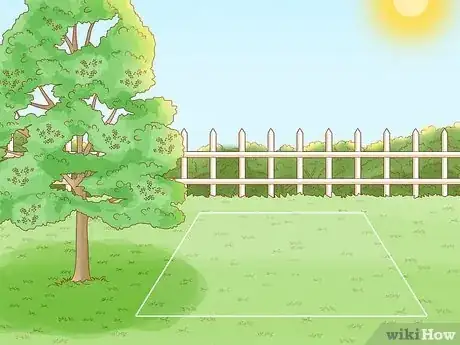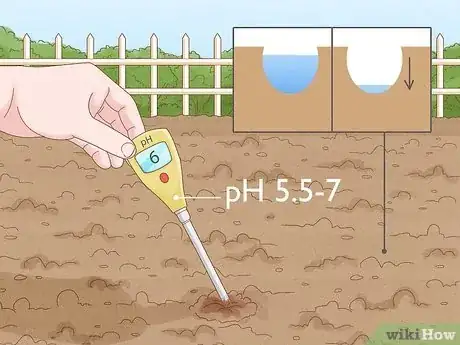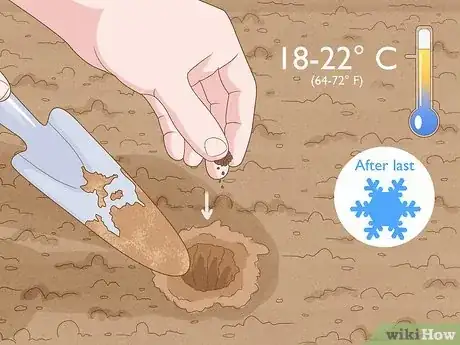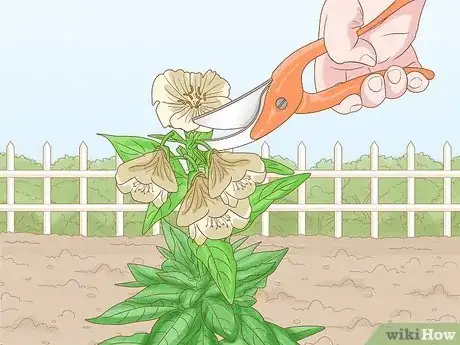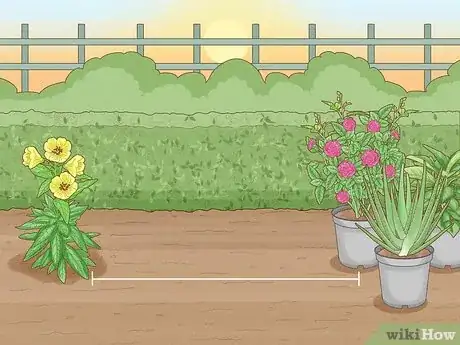This article was co-authored by Maggie Moran. Maggie Moran is a Professional Gardener in Pennsylvania.
There are 7 references cited in this article, which can be found at the bottom of the page.
wikiHow marks an article as reader-approved once it receives enough positive feedback. In this case, 100% of readers who voted found the article helpful, earning it our reader-approved status.
This article has been viewed 103,766 times.
Evening primrose is a biennial plant that's native to America. Some people consider it a weed based on its rapid self-seeding and ability to easily grow in many areas. But as long as it's kept under control, the evening primrose produces beautifully fragrant flowers that spread their petals at dusk to invite moths. It also has many significant medical properties.
Steps
Preparing the Soil and Seeds
-
1Decide if evening primrose is right for you. Be sure that it's appropriate to plant evening primrose where you are. Remember that this is a plant that spreads easily, so think about your local environment and biodiversity before planting.
- Because evening primrose spreads so rapidly, you don’t want to plant it in a place that would need a self-contained plant or one that requires much care to spread into overgrowth.
-
2Choose a mostly sunny planting location. Evening primrose grows the best in mostly sunny locations. It can survive in partial shade, but it really needs quite a lot of direct sunlight if you want to get the most out of the blooming flowers.[1]
- Evening primrose will not survive in a completely shaded area, so be sure there is some direct sunlight in the planting location you choose.
- Try to choose locations that are south-facing or west-facing, and that are somewhat sheltered from the elements.
Advertisement -
3Choose the proper soil. For evening primrose, you need to use soil that drains easily. You’ll plant the seeds in the soil and add water. But the water must be able to drain out, otherwise the plant could get overwatered. The soil should have a pH balance of 5.5 to 7.[2]
- Evening primrose will grow in cool, warm, hot, or arid places.
-
4Purchase some evening primrose seeds. You should be able to find evening primrose seeds at your local home improvement or garden store. They typically come in seed packets.
- There are also various online sources where you can buy evening primrose seeds.[3]
- You can also purchase evening primrose plants if you wish to avoid planting and tending to seeds/seedlings.
Sowing and Growing Primrose
-
1Sow the seed after the last frost. Depending on your climate, plan to plant the seeds in the springtime, after the weather has begun to warm up. Optimal temperatures for evening primrose growth range from 18 °C (64 °F) to 22 °C (72 °F).[4]
- As primarily annual plants that bloom from spring to fall, evening primrose does not tolerate cold weather very well.
- Plant the seeds in an equal mixture of soil, peat moss, and sand.
- You can plant the seeds indoors initially to help the seedlings get a jump start. If so, plant them ten weeks before the first frost-free date in your area.
- Also, make sure to place the seedlings by the windows while they are indoors to ensure they still get some direct sunlight.
-
2Transfer and/or thin out the seedlings. If you began growing your seedlings indoors to protect them from the cold, you’ll need to transfer them to an outdoor pot or into the ground soil once they have sprouted and grown up to a couple of inches. Plant the seedlings 6 inches (15 cm) deep and approximately 8 in (20 cm) apart.
- You should try to transfer as much of the original soil as possible to protect the plant’s root system.
- Dig a hole in the new container (or in the ground soil) that will hold the entire plant, soil and all. Then you can fill in any extra space with additional soil.
-
3Water the plants regularly until they're established. Once the plants are planted outside, you’ll need to water them more frequently at first. A spritz of water once every couple of days should be good, but feel free to provide additional water if the soil seems dry. However, don't over-water them -- the soil should be moist, not muddy.[5]
- Once the plants are well-established, they are quite hardy and require little maintenance (other than pruning). They can withstand hot, arid temperatures and semi-drought conditions.
- If you live in a dry climate, add a layer of mulch around the plants to help the soil retain moisture.
- Add fertilizer to the plants a few times throughout the year to help them grow.
Managing Its Spread
-
1Let it grow. Evening primrose "thrives on neglect," so it's fairly hard to lose it for lack of nurture. The real problem is keeping it under control, because it self-seeds so readily. Be prepared to clean up any spread regularly.[6]
- You will need to do very little maintenance once the plant has acclimated to its permanent location.
-
2Prune the buds. Evening primrose plants can spread quite wildly if they are not managed. Once your plant is done flowering and the blooms have faded each season, you’ll want to prune them. Just snap off the flower stems and discard them. Doing this will prevent the seeds from ripening and spreading.[7]
- It will also help your plant remain strong and sturdy while it is maturing and growing.
- If you want your evening primrose to spread, be sure to leave the buds intact. If you mow your lawn where the plants are growing, remember to raise the height of the blade so that the buds won’t be chopped off.
-
3Keep it away from other potted plants. If you have potted plants in your yard, keep them away from your evening primrose. It’s all too easy for evening primrose to spread into other potted plants and begin growing there.
- This could be problematic because it could crowd the existing plants, or overtake their root systems in the pot.
Expert Q&A
Did you know you can get expert answers for this article?
Unlock expert answers by supporting wikiHow
-
QuestionCan I keep a primrose indoors?
 Maggie MoranMaggie Moran is a Professional Gardener in Pennsylvania.
Maggie MoranMaggie Moran is a Professional Gardener in Pennsylvania.
Home & Garden Specialist
-
QuestionHow do you take care of a primrose plant?
 Maggie MoranMaggie Moran is a Professional Gardener in Pennsylvania.
Maggie MoranMaggie Moran is a Professional Gardener in Pennsylvania.
Home & Garden Specialist
-
QuestionDo primroses like sun or shade?
 Maggie MoranMaggie Moran is a Professional Gardener in Pennsylvania.
Maggie MoranMaggie Moran is a Professional Gardener in Pennsylvania.
Home & Garden Specialist
Things You'll Need
- Evening primrose seeds
- Growing area
- Pruning shears to remove flower heads before seeds ripen
References
- ↑ https://altnature.com/gallery/eveningprimrose.htm
- ↑ http://www.gardenershq.com/Oenothera-Evening-Primrose.php
- ↑ http://www.crocus.co.uk/plants/_/oenothera-biennis/classid.1000000955/
- ↑ https://www.ncbi.nlm.nih.gov/pmc/articles/PMC3923160/
- ↑ http://www.costafarms.com/plants/evening-primrose
- ↑ https://www.westcoastseeds.com/how-to-grow-guides/how-to-grow-oenothera/
- ↑ http://www.seedaholic.com/oenothera-biennis-evening-primrose.html
About This Article
To grow evening primroses, you’ll want to plant them in a sunny area with plenty of space for them to spread out. Plant the seeds in the spring after the last frost, since primroses need warm conditions. If you want to get a head start on your primroses, plant them indoors about 10 weeks before the expected last frost. Then, transfer them to an outdoor pot or ground soil when the weather warms up. You’ll need to water the seedlings every couple of days to keep the soil moist for the first few months. After that, they should survive off rain water. For more tips from our Gardening co-author, including how to manage the spread of your evening primroses, read on!

